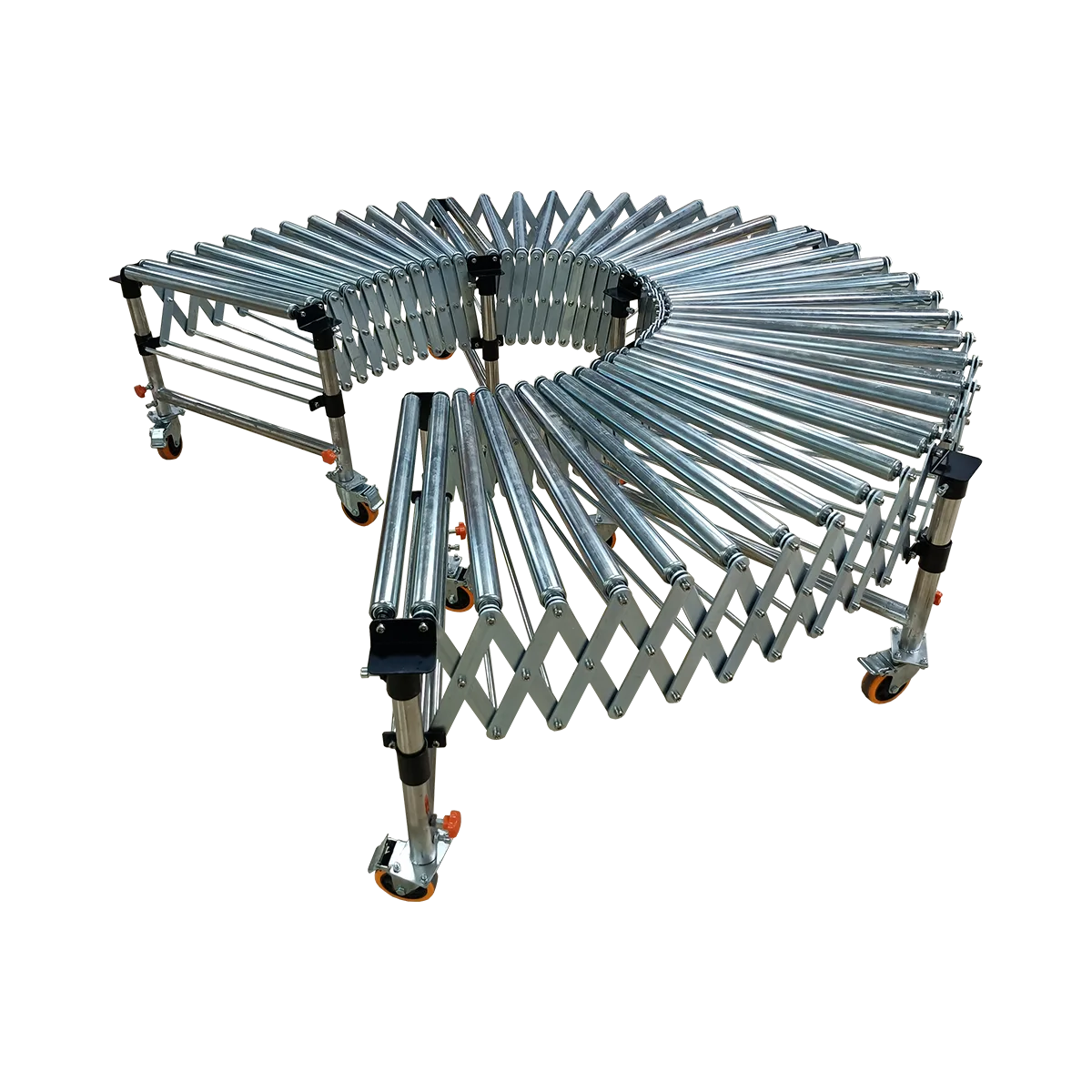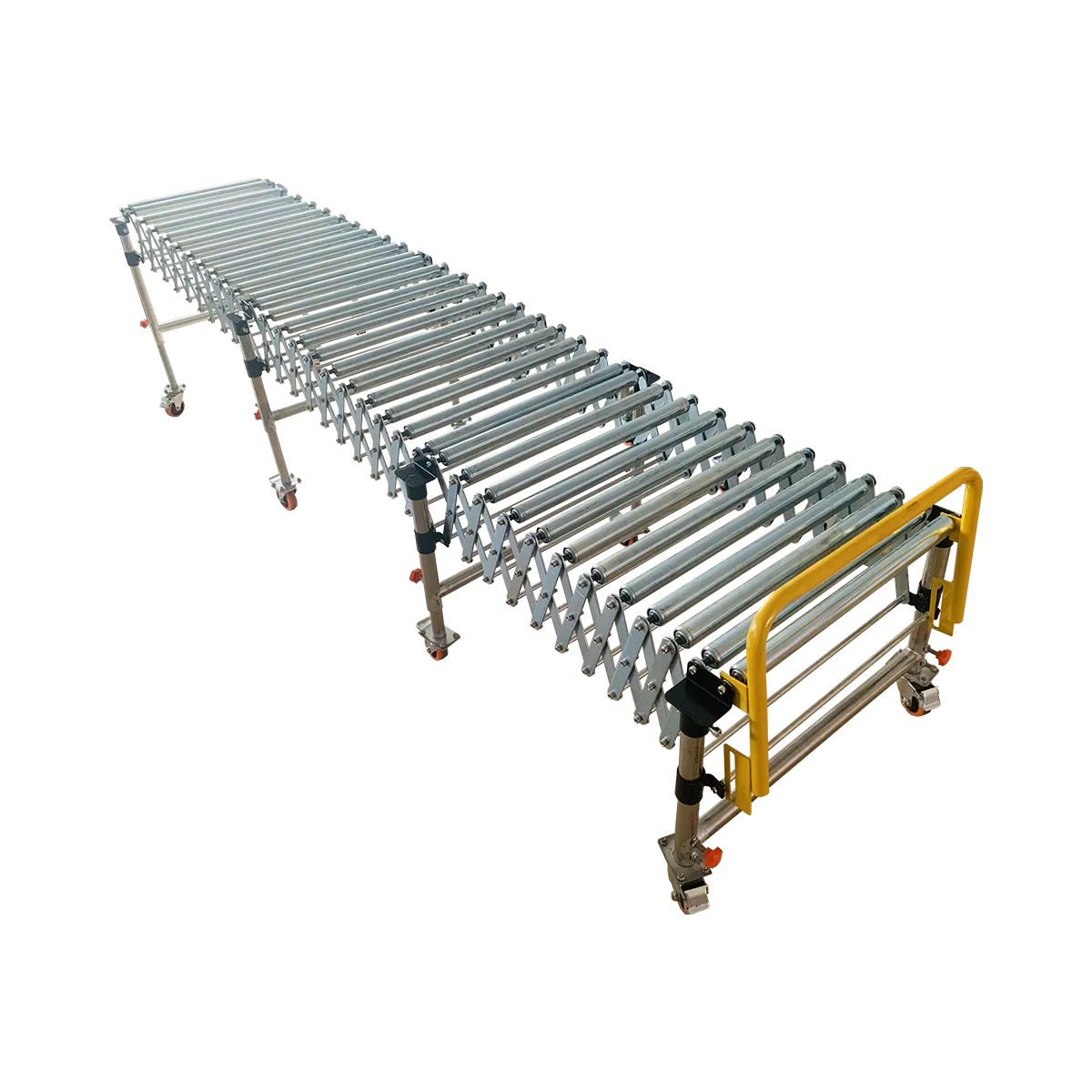Gravity Roller Conveyor Technical Dive: 38mm vs. 50mm Diameter Rollers
Explore the critical differences between 38mm and 50mm diameter rollers for gravity roller conveyor systems, including load capacity, section length, and optimal applications for warehouse efficiency.
Related Products
-
Gravity Roller Conveyor – Roller Diameter 50 mm – 1500 mm/SectionCollapsed Length
525 mm
Extended Length1500 mm
Load Capacity50 kg/m
Applicable GoodsFlat-bottomed Goods
Bagged Goods
-
Gravity Roller Conveyor – Roller Diameter 38 mm – 1700 mm/SectionCollapsed Length
485 mm
Extended Length1700 mm
Load Capacity50 kg/m
Applicable GoodsFlat-bottomed Goods
Bagged Goods
At first glance, all gravity roller conveyors might appear similar – metal frames with cylindrical rollers that move goods from point A to point B without power. However, a closer examination reveals that roller diameter is one of the most crucial specifications that significantly impacts performance, capacity, and application suitability. The choice between 38mm and 50mm diameter rollers represents a fundamental decision that warehouse managers and logistics professionals must make when selecting a gravity roller conveyor system.
This technical comparison explores the key differences between these two roller diameter options, helping you understand which configuration best suits your specific operational needs. While seemingly a small detail, this choice directly affects everything from the conveyor’s weight capacity to its section length and overall versatility.
The 38mm Roller: The Distance Champion
The 38mm roller configuration represents the lighter, more extended option in the gravity roller conveyor lineup. This smaller diameter creates distinct advantages for specific applications.
Key Specifications
- Section Length: Extends from 485mm (compressed) to an impressive 1700mm when fully extended
- Load Capacity: Rated at 50 kg/m
- Roller Spacing: 150mm between rollers
- Roller Count: 12 rollers in standard section, 11 in extension section
- Weight: Significantly lighter (20kg for 500mm width vs. 26kg for equivalent 50mm model)
- Frame Structure: 38×38mm cross-section frame with ≥1.3mm thickness
Ideal Applications
The 38mm roller configuration excels in scenarios where:
- Longer Sections Are Advantageous: The extended 1700mm section length allows for covering more distance with fewer sections
- Weight Is A Concern: The lighter construction makes repositioning and reconfiguring the system easier for staff
- Space Efficiency Matters: When fully compressed to 485mm, it takes up minimal storage space
- Handling Lighter Packages: Perfect for e-commerce operations dealing primarily with smaller parcels and boxes
- Mobile Applications: When the conveyor needs to be frequently moved between different areas
The 38mm roller’s extended reach makes it particularly valuable in applications where longer, uninterrupted sections improve workflow efficiency. The lighter weight of each section also reduces operator fatigue during setup and reconfiguration.
The 50mm Roller: The Strength Champion
The 50mm roller configuration represents the heavy-duty option, designed for more demanding applications where durability and load capacity take precedence.
Key Specifications
- Section Length: Extends from 525mm (compressed) to 1500mm when fully extended
- Load Capacity: Superior 50 kg/m rating
- Roller Spacing: Tighter 110mm between rollers
- Roller Count: 10 rollers in standard section, 9 in extension section
- Weight: Heavier construction (26kg for 500mm width)
- Frame Structure: 35×35mm cross-section frame with ≥1.3mm thickness
Ideal Applications
The 50mm roller configuration is the preferred choice when:
- Durability Is Critical: The larger diameter rollers offer enhanced strength and longevity
- Handling Smaller Items: The tighter 110mm roller spacing prevents small packages from sagging between rollers
- Stability Is Essential: The more robust construction provides greater stability under load
- High-Volume Operations: For operations where the conveyor will experience constant, heavy use
While offering a slightly shorter maximum extension (1500mm vs. 1700mm), the 50mm roller’s superior strength and closer roller spacing make it the go-to choice for operations handling heavier or smaller items that require consistent support across the conveyor surface.
Decision Framework: Choosing The Right Diameter
When selecting between 38mm and 50mm roller diameters, consider these key factors:
| Specification | 38mm Roller | 50mm Roller | Decision Factor |
|---|---|---|---|
| Load Capacity | 50 kg/m | 50 kg/m | Choose 50mm for heavier loads |
| Section Length | 1700mm max | 1500mm max | Choose 38mm for longer sections |
| Roller Spacing | 150mm | 110mm | Choose 50mm for smaller packages |
| Section Weight (500mm width) | 20kg | 26kg | Choose 38mm for frequent repositioning |
| Ideal Use Case | Lighter packages, longer sections, frequent reconfiguration | Heavier loads, smaller items, fixed installations | Based on primary operational need |
The decision ultimately comes down to your specific operational priorities. If handling heavier goods or smaller packages is your primary concern, the 50mm roller is the clear choice. If you need longer sections or frequently reconfigure your layout, the 38mm roller offers distinct advantages.
How Roller Spacing Affects Performance
Beyond diameter, the spacing between rollers significantly impacts conveyor performance. This is one of the key differences between the 38mm and 50mm models:
38mm Roller (150mm spacing)
- Advantages:
- More economical design with fewer rollers per section
- Excellent for larger boxes that span multiple rollers
- Lower weight and potentially lower cost
- Limitations:
- Small packages may sag between rollers
- Less consistent support for irregular-bottomed items
50mm Roller (110mm spacing)
- Advantages:
- Superior support for smaller packages
- More consistent movement for irregular items
- Smoother transportation with less “bumping” sensation
- Limitations:
- More rollers required per section
- Slightly heavier construction
- Potentially higher cost
The ideal spacing depends largely on your typical package size. For operations handling primarily small packages (under 30cm length), the tighter spacing of the 50mm roller configuration provides significant advantages. For larger boxes, the 38mm configuration may offer sufficient support while providing the benefit of longer sections.
Practical Considerations For Implementation
When implementing either roller diameter option, consider these practical aspects:
- Height Adjustment: Both models offer the same height adjustment ranges (450-680/550-820/750-1200/900-1500 mm), providing flexibility for different loading and unloading heights
- Width Options: Both are available in 500/600/800mm widths to accommodate various package sizes
- Material Options: Both feature ≥1.5mm thick rollers in either galvanized or 201 stainless steel options
- Slope Requirements: Both typically require a 2-5 degree slope for optimal gravity-driven operation
- Maintenance Needs: Both feature 12-month frame warranties and similar maintenance requirements
- Modular Expansion: Both can connect with additional sections to create complete conveyor lines
- Surface Requirements: Both require packages with reasonably flat bottoms for smooth operation
Remember that gravity roller conveyor specs are designed to work within specific parameters. While the system is flexible, exceeding rated capacities or using inappropriate package types can lead to premature wear or operational issues.
Conclusion: Matching Roller Diameter To Your Operational Needs
The choice between 38mm and 50mm diameter rollers for your gravity conveyor system isn’t simply about bigger versus smaller. It’s about matching the right tool to your specific operational requirements:
- Choose the 38mm roller conveyor when you need longer sections, lighter weight, and are primarily handling medium-sized packages within the 50 kg/m weight limit.
- Select the 50mm roller conveyor when handling heavier loads up to 50 kg/m, smaller packages that require closer roller spacing, or when maximum durability is essential.
By understanding the technical differences between these two options, you can optimize your conveyor system’s performance, longevity, and suitability for your specific warehouse or distribution center needs. The right choice will enhance operational efficiency while minimizing maintenance issues and maximizing your return on investment.
Frequently Asked Questions
Can I connect 38mm and 50mm roller conveyors together in the same line?
While physically possible, this is not recommended as the different heights, capacities, and roller spacings can create transition issues and potential package handling problems.
Which roller diameter is better for handling irregular-shaped packages?
The 50mm diameter with 110mm spacing generally provides better support for irregular packages, as the closer roller spacing prevents sagging and catching.
How does roller diameter affect the noise level of the conveyor?
Larger 50mm rollers typically produce slightly less noise during operation due to fewer rotations required for the same distance traveled and generally smoother operation.
Can both roller diameters handle the same temperature ranges?
Yes, both 38mm and 50mm roller conveyors have similar temperature tolerance ranges. For extreme environments, consult with the manufacturer about specialized materials.
What is the typical lifespan difference between 38mm and 50mm roller conveyors?
With proper maintenance, both systems can last 5-10+ years. The 50mm system may demonstrate slightly longer bearing life under heavy use due to its more robust construction.
Table of Contents
Recent Posts
Discover how to select the perfect conveyor width for your warehouse operations. Our expert guide helps you match box sizes to conveyor dimensions for optimal efficiency and fewer jams.
Discover effective outdoor conveyor solutions for connecting warehouse to truck across open yards. Our guide to all-weather yard logistics will transform your loading efficiency.



